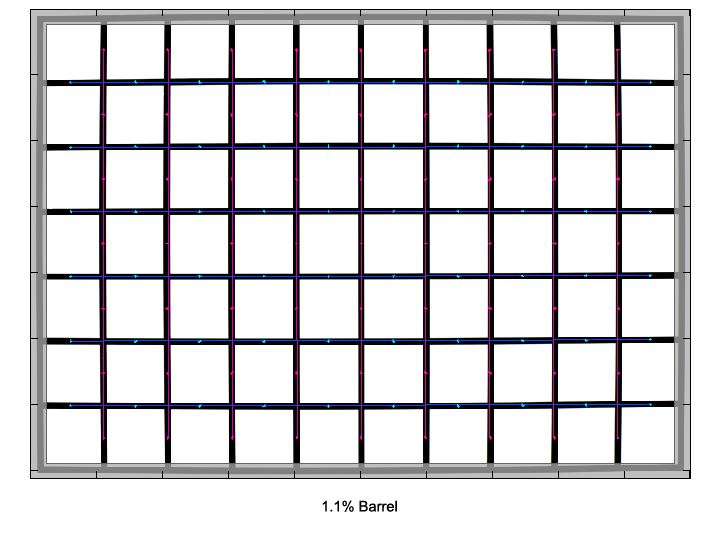|
Page 2 of 3

Distortion
The lens produces a moderate amount of barrel distortion. This is not outstanding, but actually quite typical behaviour for a normal prime.

The chart above has a real-world size of about 120x80cm.
Vignetting
Vignetting is automatically corrected on digital M cameras, when the lens is either 6-bit coded or manually selected from the camera's menu. Since this correction is optional and can be switched off (by disabling lens detection), we provide both the lens' native vignetting as well as corrected figures.
Being an ultra-fast lens, the Noctilux unsurprisingly shows a hefty amount of vignetting wide open. As usual the amount of light fall-off can be reduced by stopping down, however one needs to stop down to f/2.8 or beyond to reach a level of vignetting that can be considered negligible.
When corrected by the camera, vignetting is reduced somewhat throughout the whole aperture range, but remains on a very high level at large apertures.
Please note that this automatic correction is also applied to the raw DNG file and (regardless of whether it is done in camera or in post) doesn't come for free. Making the image borders lighter boosts the signal level as well as the noise level, thus leading to more visible noise than if there had been no vignetting.

MTF (resolution)
The Noctilux ASPH delivers very good center resolution at the largest aperture setting, increasing to excellent figures by stopping down. The peak value is reached at f/2.8. From f/8 onwards, diffraction noticeably comes into play and reduces the resolution figures again.
The image borders and extreme corners are a very different story, though. At large apertures, there is hardly anything worth to be called resolution. The situation changes drastically when stopped down to f/2.8 or beyond, where these regions recover to good (f/2.8) or even very good levels (f/4 and beyond).
Since fast primes often suffer from this issue, it is worth to mention that the Noctilux showed only a very small amount of focus shift when stopping down (residual spherical aberration).
Please note that the MTF results are not directly comparable across the different systems!
Below is a simplified summary of the formal findings. The chart shows line widths per picture height (LW/PH) which can be taken as a measure for sharpness.
If you want to know more about the MTF50 figures you may check out the corresponding Imatest Explanations

Chromatic Aberrations (CAs)
Chromatic aberrations (color shadows at harsh contrast transitions) are most pronounced wide open, reaching a peak value of above 2 pixels at the image borders. By stopping down, the level of CAs slowly decreases to less noticeable levels.

Bokeh
Of course, one of the main characteristics of a very fast lens (and to some maybe the most important aspect) is how the lens renders out of focus areas, the so-called bokeh.
The Noctilux certainly delivers in this regard. Image blur is very smooth both in front of and behind the plane of focus. At very large apertures, though, the bokeh can be "swirly" in the image borders. This is mostly due to the cut-off effect, which is caused by mechanical vignetting and also visible in the rendering of background highlights in the image below.
Apart from the vignetting, background highlights show a small amount of outlining (especially at larger distances, see the sample images on the next page), but compared to older designs, especially the f/1 predecessor of the Noctilux ASPH, the outlining issue is reduced considerably and the overall bokeh quality a lot smoother.
Typical for very fast primes, background highlights suffer a bit from bokeh fringing (see next section).

Bokeh Fringing
Bokeh fringing is a common issue with fast glass. It's visible as halos of different colors in out-of-focus areas - magenta (red + blue) in front of the focus point
and green beyond.
Being a very fast lens, it's no surprise that the Noctilux shows a fair amount of bokeh fringing at large apertures. As usual, stopping down reduces the issue considerably.
Please note that in the images below there is also a colour artefact in the ruler-like structure, right behind the plane of focus. These are moire artifacts resulting from the lack of an anti-aliasing filter in the M9, so they are not rendered by the lens, but an issue of the camera's sensor design.
|